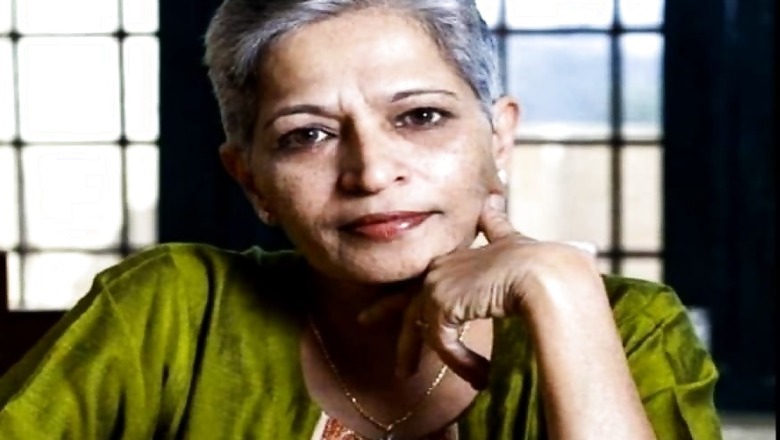
views
Sridhar, former member of Karnataka State Committee of the Communist Party of India (Maoist), gave up arms to continue his struggle for social justice and equality in a democratic way. He says, while he decided to leave the Naxal movement after his differences with the leadership, Gauri Lankesh was among the few people who stood by him during his transition from an armed rebellion to a democratic campaigner. He writes a tribute to the ‘big’ power of ‘small’ Gauri:
They have killed Gauri ma’am.
They finally killed Gauri ma’am.
They have taken Gauri ma’am away from us.
No matter how many times one utters this, it does not sink in. We are all out on the streets. We are doing whatever we think should be done to express our outrage. We are shouting in one voice. Wiping away our tears and swallowing our anger, we are protesting saying ‘I am Gauri’. We have organised a protest today. There are moments when it feels like Gauri is taking part in the preparations.
Over the past few years, there has been no agitation I have taken part in without her being involved in it. She was there in all these activities. Be it at the forefront, in the background or as a fellow traveller, she was our trusted aide. You could fight with her, raise your voice at her, be carefree, and you could work with her despite differences.
She used to say that she was not a communist, “I am a bourgeois”. She used to tease us saying “You communists talk so much... you have day-long meetings”, asking us if she should prepare some food. She used to worry at the beginning of the month about how she would raise the money to pay salaries to her staff, who used to help her bring out the Gauri Lankesh Patrike.
She used to feel proud saying that her son Kanhaiya had visited. “I took him for a haircut, gave him the laptop someone had given me because he didn’t have one”. She used to share the troubles of the world with ease. She used to recount the times when she and Vimala [of All India Democratic Women’s Association] used to tell [Chief Minister] Siddarmaiah to put an errant godman behind bars. She used to happily recount recent Facebook exchanges where she got the better of some right-wing troll.
She used to tell us how she got a CCTV camera fitted in her house, “Not because it is of any use to me, but so that you can catch the person who murders me”, joking even about death. She became for revolutionaries a fellow traveller, mother, sister, and ma’am who had become an intrinsic part of our lives.
In reality, Gauri was not a great leader or thinker. She did not have any dreams or plans for her paper, for social reforms, about her future or that of her family. She lived for the day. She used to accompany those she felt were correct, and she did what she felt was correct. She was moved by her conscience. Some thought this was not a very profound personality. But what we do matters more than what we talk. Gauri persistently worked towards relieving society of its pain, doing all that was possible.
Gauri’s biggest worry was the hatred that was growing around her, and the Sangh Parivar that was sowing the seeds of this hatred. The love inside her found it hard to live with this hatred spreading all around her, which is why she wrote about it, spoke about it, organised people against it, protested against it and eventually was killed by it. This is why she has become a source of strength and inspiration now.
The Sangh labelled Gauri a Naxalite a long time ago. In some ways, Gauri was all these things, and in other ways she was none of these. She worked with Communists, but she herself wasn’t one. She supported Dalit movements but wasn’t an Ambedkarite.
She was in contact with Naxalites but wasn’t one. She supported movements for justice wherever she was, which is why she was never attached to one, never overly criticised any of these, and was with all these, supporting the best in these movements. She called Jignesh Mevani of the Una Dalit movement, Kanhaiya Kumar who is Communist, and Umar Khalid, who supports the far left, her children because of her overarching ideals.
Along with the politics of hate that was growing at the time, Gauri was also alarmed by the armed uprising that was taking shape in Karnataka. In 2004, when she met [Naxalite leader] Saketh Rajan in the forests of the Malnad region, she was possessed by two thoughts.
While on the one hand she admired the commitment of those who left their homes to live in the forests braving the elements to fight for change in society, she was also worried about the response to this. Soon enough, the encounter killings began. And she mourned each death.
To stop this, Gauri decided to launch the Citizens’ Initiative for Peace with like-minded people. They pleaded that the state and Naxalites should not fight each other but discuss problems to find solutions. While both sides agreed, the government reneged on its promises and began combing operations. It killed Saketh Rajan.
Condemning this, Gauri began to write about it, and hit the streets, and the Sangh Parivar began calling her a Naxalite. This was the reason behind her falling out with her brother Indrajit. The Sangh Parivar labelled her as a sympathiser of armed uprisings, although she had worked for peace.
Across the country now a rumour has been systematically spread that Gauri was killed by Naxalites. Those celebrating her death are the ones spreading this. Those who labelled her an agent of Naxals are now constructing the story of her being murdered by Naxalites. Those who cried themselves hoarse, when Sirimane Nagaraj and I gave up arms, saying that this was a new Naxal conspiracy and that it was all a lie, are the ones spreading the canard that it was because of her work rehabilitating Naxals that she was killed.
To tell you the truth, Naxals had a hundred-fold more admiration for Gauri than what she had for Naxals. The Naxal movement is not about walking around with sickles like rowdies, nor about killing people for money like underworld gangs, or like terrorists who show their strength by randomly bombing places. It is a movement based on an ideology, and though we might not agree with the ideology, we cannot question its aims. It is a crime to even think that Naxals would kill Gauri.
It is hard to even imagine the pain that Vikram Gowda, that poor Adivasi youth who joined the Naxal movement because of government’s move to evict Adiviasis from the forest, must be feeling with the fake news being spread that he killed Gauri. There are a hundred reasons why I say that it is not possible that Naxals killed Gauri. But I will list them some other day.
The right-wing forces, which killed Gauri to stifle her voice, the central government and sections of media have been caught unaware by the reaction of the people of this nation, and have joined hands to shift blame on to the Naxals.
Along with Gauri, they are out to murder the reality of this land. But Gauri has beaten awake the conscience of the country. In one voice humanity has raised the call ‘I am Gauri’, and the life-and-death fight for the soul of this nation has reached a new phase. The ‘small’ Gauri we love has become a ‘big’ source of strength and is leading us ahead.
Salaam Madam.
I am Gauri.
— Noor Sridhar.
(Views expressed are personal)



















Comments
0 comment